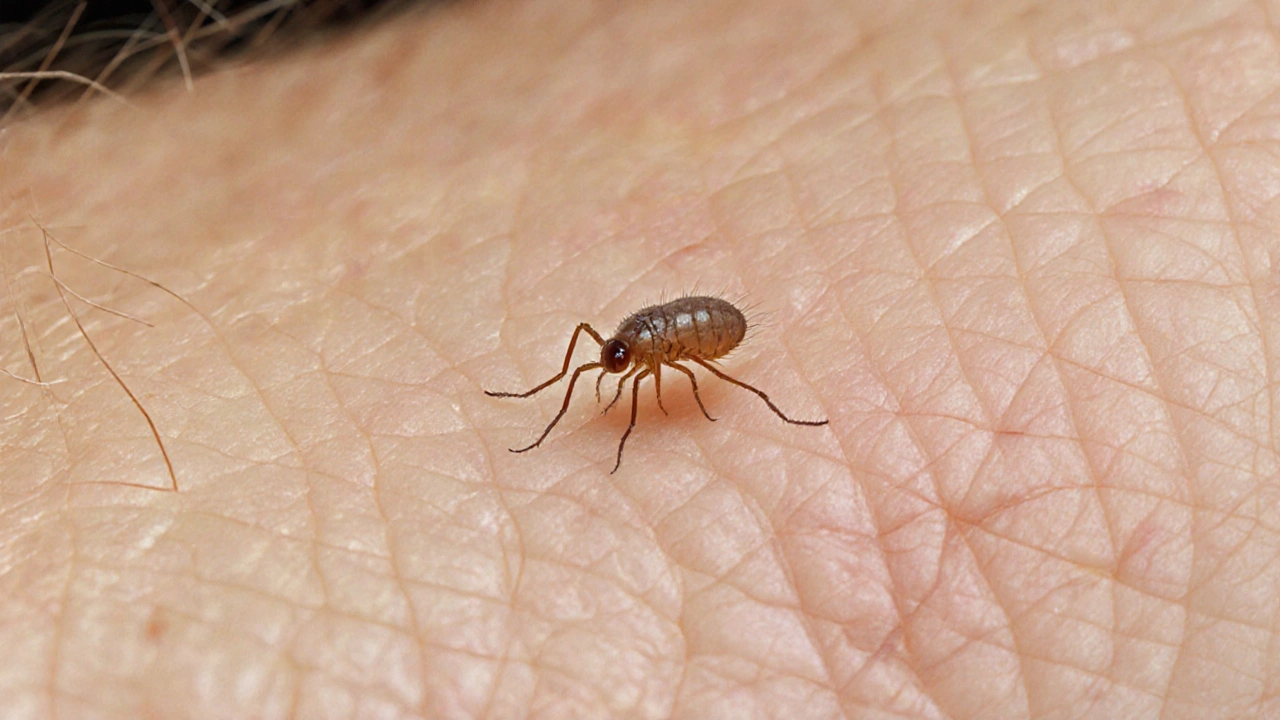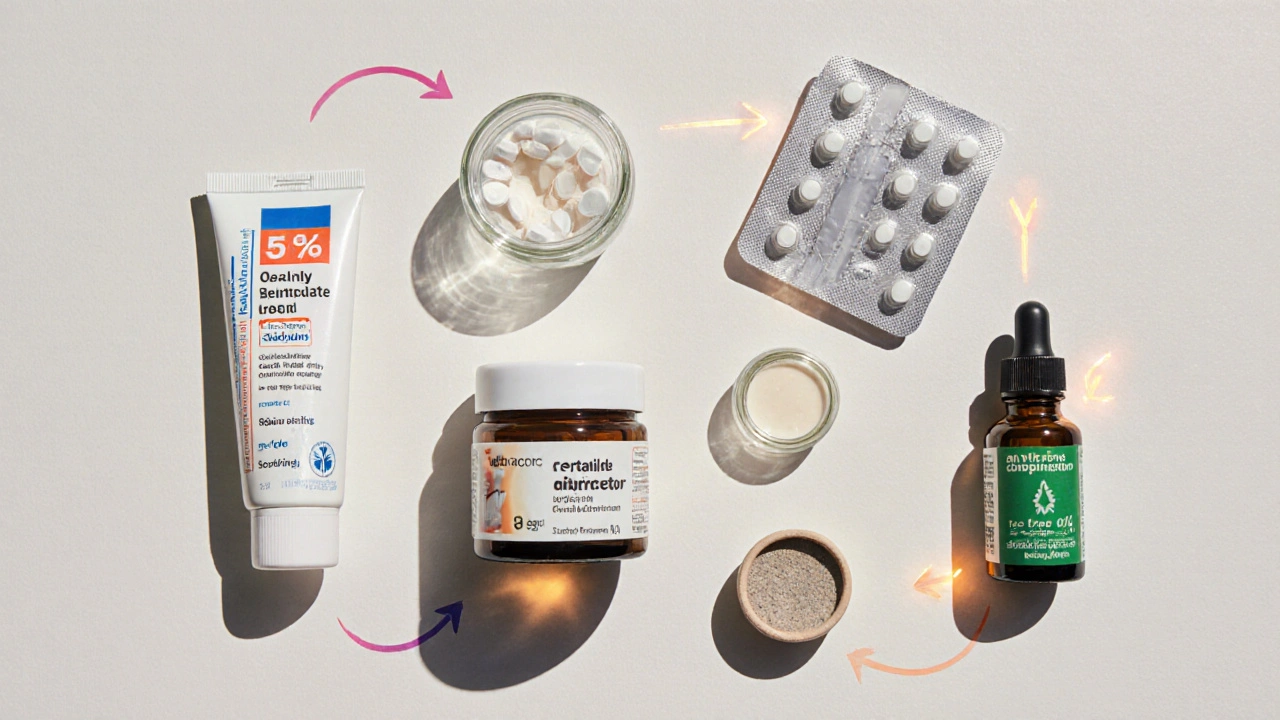Elimite (Permethrin) vs Other Scabies Treatments: Which Is Best?

Scabies Treatment Comparison Tool
High Efficacy
Most widely recommended first-line therapy for scabies with ~95-98% cure rate.
Age: Safe ≥2 months
Cost: $15-20
Effective for Severe Cases
Strong alternative for resistant cases or large outbreaks.
Age: Safe ≥15 kg
Cost: $10-12
Affordable Option
Cheaper but can irritate sensitive skin.
Age: Avoid broken skin
Cost: $3-5
Dual Action
Kills mites and relieves itching.
Age: Generally safe
Cost: $4-6
Safe for Infants
Excellent safety profile, ideal for infants under 2 months.
Age: Safe for all ages
Cost: $2-4
Natural Alternative
Limited evidence, potential for allergic reactions.
Age: Caution advised
Cost: $8-10
Treatment Recommendations
Select your situation to get personalized recommendations:
Recommended Treatment:
Your personalized recommendation will appear here.
When a nasty case of scabies shows up, the first thing most people look for is a fast, safe way to get rid of the itch and the mites. Elimite (Permethrin) is the name you’ll see on many pharmacy shelves, but it’s not the only option. Knowing how Elimite stacks up against other treatments helps you pick the right plan for you or your family.
Quick Takeaways
- Elimite (permethrin 5%) is the most widely recommended first‑line therapy for scabies.
- Oral ivermectin is a strong alternative for resistant cases or large outbreaks.
- Topical benzyl benzoate and crotamiton are cheaper but can irritate sensitive skin.
- Sulfur ointment is safe for infants but needs longer treatment.
- Choosing the right product depends on age, skin condition, and the severity of infestation.
What Is Elimite (Permethrin)?
Elimite is a 5% permethrin cream approved by the U.S. Food and Drug Administration (FDA). It works by disrupting the nervous system of the scabies mite, Sarcoptes scabiei, leading to rapid death of the parasite.
Permethrin belongs to the pyrethroid class of insecticides, a group known for quick knock‑down action and low toxicity to humans when used as directed. In clinical trials, a single overnight application of Elimite cured over 95% of cases after just one treatment.
How Does Permethrin Work?
Permethrin binds to voltage‑gated sodium channels in the mite’s nerve cells, keeping them open and causing a continuous influx of sodium ions. This overstimulation paralyzes the mite within minutes, and the organism dies shortly after.
Because the compound is poorly absorbed through intact human skin, systemic exposure remains minimal, which is why it’s considered safe for most age groups, including children over two months in many countries.

Key Alternatives to Elimite
While Elimite is front‑line therapy, several other agents are used when permethrin isn’t available, when patients experience irritation, or when the infestation is widespread.
Ivermectin (Oral)
Ivermectin is an oral antiparasitic approved for scabies in a single dose of 200µg/kg, often repeated after one week for severe cases.
It binds to glutamate‑gated chloride channels in the mite, causing paralysis and death. Ivermectin shines in crusted (Norwegian) scabies and in institutional outbreaks where topical coverage is hard to achieve.
Benzyl Benzoate (Topical)
Benzyl benzoate is a liquid formulation (10‑25%) applied to the whole body, left for several hours, then washed off.
Its mechanism is similar to pyrethroids-disrupting nerve function-but it can cause a burning sensation, especially on broken skin. It’s affordable and widely available in low‑resource settings.
Crotamiton (Topical)
Crotamiton is a 10% cream that both kills mites and relieves itching.
It works by interfering with the mite’s nervous system, though its kill rate is slower than permethrin. Some users report mild skin irritation, but it’s generally well tolerated.
Sulfur Ointment (Topical)
Sulfur ointment (5‑10%) is a classic, oil‑based treatment used for decades.
It kills mites by disrupting cell membranes, but the treatment must be applied nightly for 3‑5 days and often leaves a noticeable odor. Its safety profile is excellent, making it the go‑to for infants under two months.
Tea Tree Oil (Natural)
Tea tree oil contains terpinen‑4‑ol, which shows modest acaricidal activity in lab studies.
Evidence from human trials is limited, and the oil can cause allergic dermatitis in sensitive individuals. It’s sometimes used as an adjunct for mild cases.
Comparison Table
| Product | Mechanism | Formulation | Typical Regimen | Efficacy (single course) | Safety / Age Limits | Cost (US$) |
|---|---|---|---|---|---|---|
| Elimite (Permethrin 5%) | Na⁺ channel blocker | Cream | Apply overnight, wash off next morning | ~95‑98% | Safe ≥2months; mild irritation possible | 15‑20 |
| Ivermectin (oral) | Glutamate‑gated Cl⁻ channel agonist | Tablet | 200µg/kg, repeat in 7days for severe | ~90‑95% (single dose) | Contraindicated in pregnancy; safe ≥15kg | 10‑12 |
| Benzyl Benzoate | Na⁺ channel disruptor | Liquid (10‑25%) | Apply 6‑12h, repeat after 24h | ~80‑85% | Can burn; avoid on broken skin | 3‑5 |
| Crotamiton | Neurotoxin & antipruritic | Cream (10%) | Apply 24h, repeat after 24h | ~70‑80% | Generally safe; mild irritation | 4‑6 |
| Sulfur ointment | Membrane disruptor | Ointment (5‑10%) | Nightly 3‑5days | ~65‑75% | Excellent safety; odor, staining | 2‑4 |
| Tea Tree Oil (5%) | Terpinen‑4‑ol acaricidal | Oil blend | Apply twice daily 5days | ~50‑60% (limited data) | Allergic dermatitis risk | 8‑10 |
When to Choose Elimite Over Others
If you need a cure that works quickly, with minimal side effects, and you’re treating a typical community outbreak, Elimite is usually the best bet. Its single‑night application means less hassle for families with kids who hate long‑lasting creams.
Health agencies like the World Health Organization (WHO) list permethrin as the first‑line drug for both classic and crusted scabies, reinforcing its global acceptance.

Scenarios Where Alternatives Shine
- Crusted scabies or institutional outbreaks: Oral ivermectin covers the whole body from the inside out, reaching mites hidden in thick skin.
- Infants under two months: Sulfur ointment avoids the rare risk of systemic absorption from permethrin.
- Severe skin irritation: Crotamiton or low‑concentration benzyl benzoate may be gentler, though efficacy drops slightly.
- Limited budget or remote areas: Benzyl benzoate and sulfur are inexpensive and often stocked in basic clinics.
- Preference for natural products: Tea tree oil can be added for mild cases, but it shouldn’t replace medically proven treatments.
Safety Tips and Common Pitfalls
Regardless of the product you pick, follow these golden rules:
- Wash bedding and clothes in hot water (≥60°C) and dry on high heat after treatment.
- Treat all close contacts at the same time-even if they feel fine.
- Don’t apply creams to broken skin; it raises irritation risk and can increase absorption.
- For Elimite, keep the cream on for the full overnight period; rinsing early cuts efficacy.
- If itching persists after two weeks, a second course may be needed, but double‑check with a clinician.
Misusing the drugs-like mixing benzyl benzoate with other topicals-can cause severe burns. Always read the label or ask a pharmacist.
Bottom Line: Pick the Right Tool for Your Situation
Elimite (permethrin) remains the gold standard for uncomplicated scabies because it balances high cure rates, low toxicity, and easy application. However, the landscape isn’t one‑size‑fits‑all. Oral ivermectin handles heavy infestations, sulfur protects the tiniest infants, and cheaper options keep treatment accessible worldwide.
Talk to a healthcare professional, consider age, skin condition, and outbreak size, then choose the product that ticks the most boxes for your case.
Frequently Asked Questions
Can I use Elimite on a newborn?
Elimite is generally approved for children two months and older. For newborns, sulfur ointment or a pediatrician‑prescribed low‑dose ivermectin (if justified) is safer.
How long after treatment will the itching stop?
Itching often persists for up to 2‑3weeks because dead mites and their debris continue to irritate the skin. If it lasts longer, see a clinician for a possible second treatment.
Is oral ivermectin safe during pregnancy?
Current guidelines advise against routine use of ivermectin in the first trimester. Pregnant women should discuss alternative topical options with their doctor.
Why did my doctor prescribe benzyl benzoate instead of permethrin?
Benzyl benzoate is often cheaper and more widely stocked in low‑resource clinics. It may also be chosen if a patient has a known sensitivity to pyrethroids.
Can I reuse the same cream bottle for a second treatment?
Yes, as long as the product is still within its expiration date and the container is sealed. However, avoid contaminating the tube with water or other substances.

Nina Vera
October 10, 2025 AT 21:21Can you feel the drama of scratching every night? Scabies is the ultimate itch‑battle, and Elimite swoops in like a superhero cape, promising relief with just one overnight stay. Imagine the peace of mind when the tiny critters are finally evicted, and the whole family can sleep without the midnight rash parade.
Christopher Stanford
October 10, 2025 AT 21:38Statistically, permethrin shows 95-98% success, but beware of the outliers where the mites develop resistance. Also, the cost differential between ivermectin and benzyl benzoate is negligible, however the side‑effect profile of benzoate is significantly worse, especially on compromised skin. Minor typo errors in med‑labels can cause misuse, so double‑check dosages.
Steve Ellis
October 10, 2025 AT 21:55Team effort, folks! If you pick Elimite, remember to treat all close contacts at the same time-no one wants a lingering hotspot in the household. I’ve seen families bounce back in a week when everyone follows the guidelines, and that’s the kind of victory worth cheering for.
Jennifer Brenko
October 10, 2025 AT 22:11From a North‑American public‑health perspective, permethrin remains the gold standard for a reason: it balances efficacy with safety across diverse populations. In regions where budget constraints dictate otherwise, benzyl benzoate may be employed, yet the risk of severe skin irritation must be communicated clearly to patients.
Harold Godínez
October 10, 2025 AT 22:28Let’s keep the grammar clean while we talk meds. The phrase "apply overnight" means you should leave the cream on for the full sleep period-not just a quick dab before getting up. Also, avoid the temptation to re‑apply sooner; that cuts the effectiveness dramatically.
Michael Weber
October 10, 2025 AT 22:45Consider the philosophical underpinnings of parasitic eradication: we confront an external adversary, yet the true battle lies within our own skin’s ecosystem. Elimite’s precise Na⁺ channel blockade is a marvel of targeted chemistry, offering a near‑perfect cure rate while preserving human cellular integrity. One must weigh the ethical implications of using systemic agents like ivermectin only when topical solutions are insufficient.
Blake Marshall
October 10, 2025 AT 23:01Yo, everybody forgets that permethrin is the go‑to cuz it’s cheap and workz well. If you can’t get it, try the cheap benzoate but watch out for burnz. Also, don’t miss the second dose if ya have crusted scabies-those mites are sneaky af.
Shana Shapiro '19
October 10, 2025 AT 23:18My thoughts are with anyone suffering this uncomfortable condition; the key is to stay calm and follow the treatment schedule exactly. A gentle reminder: washing all bedding in hot water will prevent re‑infestation, and it spares loved ones from enduring the same itch.
Jillian Bell
October 10, 2025 AT 23:35Did you know that some pharmaceutical companies hide the true side‑effects of permethrin to keep profits high? There’s a whole network of covert labs pushing alternative “natural” remedies, but those are just smoke and mirrors. Stay vigilant.
Lindsey Bollig
October 10, 2025 AT 23:51Feeling hopeful? I’ve helped dozens of friends pick the right scabies cure, and most of them swear by Elimite for fast relief. Remember, a positive attitude speeds recovery-keep your chin up and trust the process!
Daniel Buchanan
October 11, 2025 AT 00:08Inclusivity matters even in treatment choices; ensure that everyone in a shared living space, regardless of age or background, receives the same level of care. When you educate the whole group, you eliminate pockets of missed treatment and foster a supportive environment.
Lena Williams
October 11, 2025 AT 00:25When you dive into the literature on scabies therapies, you quickly discover a cascade of considerations that extend far beyond the simple efficacy percentages presented on the surface. First, the pharmacokinetics of permethrin demand that the skin barrier be intact; any breach can dramatically increase systemic absorption, which is why many clinicians emphasize the avoidance of broken skin during application. Second, the socioeconomic context cannot be ignored; in low‑resource settings, the affordability of benzyl benzoate and sulfur ointment often dictates the therapeutic algorithm, even though their cure rates hover lower than that of permethrin. Third, patient compliance is a critical variable-an overnight application of Elimite requires a level of discipline that some families may find challenging, especially when children resist staying covered for several hours. Furthermore, the psychological impact of persistent pruritus must be acknowledged; itching can linger for weeks after successful eradication because of the inflammatory response to dead mites, and this can be misinterpreted as treatment failure. Fourth, special populations such as infants under two months are best served by sulfur ointment due to its minimal systemic absorption profile, despite the inconvenience of a strong odor and longer treatment course. Fifth, resistance patterns are emerging in some regions, and oral ivermectin, with its distinct mechanism targeting glutamate‑gated chloride channels, provides a valuable alternative for crusted scabies where topical agents struggle to penetrate hyperkeratotic lesions. Sixth, the importance of environmental decontamination cannot be overstated; washing bedding and clothing at temperatures above 60 °C breaks the life cycle of the mite and prevents reinfestation. Seventh, clinicians must be wary of off‑label uses; while tea tree oil is marketed as a natural cure, its variable concentration of terpinen‑4‑ol leads to inconsistent outcomes and a risk of allergic dermatitis. Eighth, the role of patient education is paramount; clear instructions about dosing intervals, repeat applications, and the necessity of treating all contacts can dramatically improve overall cure rates. Finally, integrating a holistic approach-combining pharmacologic therapy with proper hygiene practices, environmental control, and psychosocial support-optimizes recovery and minimizes the chance of recurrence. In summary, the choice of scabies treatment is a multidimensional decision influenced by efficacy, safety, cost, patient age, skin condition, compliance, resistance patterns, and broader public health considerations.
Stacy Whitman
October 11, 2025 AT 00:41I prefer sulfur ointment for infants.